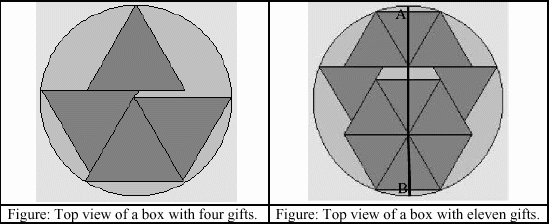
| The Gift Wrappers of Hollywood |
A group of gift wrappers were having a good time in Hollywood. They used to pack gifts for the stars of Hollywood who only wanted the gift boxes to be attractive. But recently they are having a bad time as a group of mathematicians, problem setters and programmers have come to Hollywood. News has spread out in the air that they are trying to arrange a programming contest (Just imagine a contest team consisting Jim Carrey, Mr. Bean and Bill Cosby. Are you looking for a better trio? OOPS!!). The gift wrappers are given the responsibility of making the gift boxes for the contestants but the conditions of making the gift boxes are not simple. They are given below:
The contest organizing committee has supplied them the volume of one gift L. They will have to design the gift boxes with minimum radius r4 and r11 that can hold all the gifts. Here r4 is the minimum possible radius of the box with four gifts and r11 is the minimum possible radius of the box with eleven gifts. The figure below shows how the gift wrappers can put four and eleven gifts optimally in the gift box. The figure with eleven gift boxes is symmetric along the line AB. The helpless gift wrappers have got hold of you and they have requested you to find the minimum possible radiuses for them.

2 0 2.30940107
Case 1: 0.000????????? 0.000????????? Case 2: 2.264????????? 3.428?????????